 Parish Church of St.George, West Grinstead Parish Church of St.George, West Grinstead | |
| 50°58′25.0″N 0°20′1.7″W / 50.973611°N 0.333806°W / 50.973611; -0.333806 | |
| OS grid reference | TQ 17095 20684 |
|---|---|
| Location | Rectory Lane, West Grinstead |
| Country | England |
| Denomination | Church of England |
| Website | www |
| History | |
| Dedication | Saint George |
| Dedicated | c.1100 |
| Architecture | |
| Heritage designation | Grade I NHLE 1284797 |
| Designated | 12 September 1959 |
| Style | Norman |
| Completed | 14th century |
| Specifications | |
| Bells | 6 |
| Administration | |
| Diocese | Chichester |
| Parish | West Grinstead |
St George's Church is an Anglican church in West Grinstead, West Sussex, England. It is in the Diocese of Chichester, occupying a rural position in the Sussex Weald by the River Adur. The oldest extant part of church dates from the early 11th century with additions in the 12th and 13th centuries. A south chapel was added in the 14th century.
The church contains a number of brasses and monuments that are of national importance and retains a number of features from its pre-reformation history. The chancel has some stained glass dating to the 14th century. It is the Parish church of West Grinstead with the mission shared with St. Michael and All Angels in Partridge Green. St George's is recorded in the National Heritage List for England as a Grade I listed building.
Early history
The parish church of St George, West Grinstead in West Sussex, England stands at the northerly head of the western River Adur navigation near to Bines Bridge the highest point of the tidal reach and about a 0.5 miles (0.8 km) east from Knepp Castle. It does not occupy a position in a nucleated village with just a handful of properties including the Grade II Glebe House (formerly the Rectory) adjacent to its boundaries. There is an ancient causeway leading south from the church to the Adur where a wharf once stood. A bridge over the river leads to the hamlet of Butcher's Row. The church is constructed of sandstone, rendered, with roof and much of the paving of Horsham Stone.
There is no mention of the parish of West Grinstead in the Domesday Book of 1086 but the living was a rectory by 1215 and is mentioned in the Taxation of Pope Nicholas IV in 1291 It was part of the possessions of the De Braose family, and the Manor passed successively to the Halsham, Seymour, Shirley, Caryll, and Burrell families, most of whom are represented in the monuments and antiquities in the church. Some have been laid to rest in the church.
According to John Warren FRIBA there is no easy explanation for the sequence of building of this church. The nave is late 11th-century and to which was attached a gothic tower in the early 13th-century. The date of the spire is likely 14th-century. The nave was extended about the same period and a new chancel was added. This has led to the tower being in the south aisle. In the south-east corner is the chapel of the Blessed Mary, altered in the 15th-century and the resting place of benefactor Sir Hugh Halsham The entrance to the church is via a late medieval porch constructed of Sussex winklestone and unusually on the north side. The original entrance is opposite but no longer in use.
The west end of the north wall of the nave has characteristics of an older building. There are large corbels above the northern arch which suggest this was once an external wall. The distinctive herringbone masonry visible externally and the narrow rounded windows into the porch are Romanesque and characteristic of the 10th-century and thus before the Norman Invasion. Thus it is possible that St.George's became adjoined at some point or incorporated into an older late Saxon building. An alternative viewpoint is that a small 11th-century building stood in the west end of the nave and that an unattached bell tower stood nearby becoming linked sometime in the 13th-century. After the spire was added in the 14th-century, thereafter St.George's has been externally little altered.
Interior
The nave and chancel
There is no structural division between the nave and the chancel which is covered by a single framed braced collar roof, possibly 14th-century. The north wall is 11th century and just discenible to the east of the entrance is the degraded, remnant of a late medieval wall mural in faded colours of red and yellow ochre, lime white, carbon black, and green from copper carbonate. It depicts St.Christopher carrying the Christ Child across the river. St George's church is on high ground next to a river in an area that was largely marshy in the medieval period. The windmill in the top left of the mural places the scene in a local context. The oak pews are mainly 16th and 17th-centuries in origin with some 19th-century additions.The back of each pew has the names of local farms, most of which are still extant. The pulpit is of early 18th-century construction in oak, relatively unadorned. The lectern is also oak and dates from 1891. There was a major renovation of St.George's in 1890 during which a gallery was removed and a rood screen, using 17th and 18th-century components, was placed in the chancel.
The reredos and panelling depicting the Annunciation in raised polychrome figures on oak panels are by C.E.Kempe & Co. There are a number of other features that have survived the iconoclasm of the Reformation, no doubt due to the strong recusant tradition of local families that included the Carylls, who purchased West Grinstead manor in the 1620s. There is an aumbry in the north wall where the consecretated vessels used for the Eucharist would have been kept and behind the altar a greater recess where a votive relic may have been kept
The chapel of the Blessed Mary
The first mention of a Lady Chapel which is situated in the south-east corner of the church is in 1442 It was stipulated that it would be renovated as a chantry chapel for the repose of Sir Hugh Halsham, a veteran of the Battle of Agincourt, and his second wife Phillippa. Other members of his family are also laid to rest in the Chapel. There are important brasses of Lord and Lady Halsham dating to the 1440s and a piscina, a stone basin used for the ablution of the communion vessels after Mass in Catholic and pre-Reformation churches remains. The altar that likely stood in the chapel is missing. On the west wall of the chapel is a Baroque cartouche shaped mural to Richard Caryll (d.1701) and his wife Frances (d.1704) and to his brother Peter, a benedictine monk who died at the English seminary in Douai. The work is attributed to William Woodman the Elder (1654-1731). Beneath the chapel is the vault of the Burrell family and on the south wall a memorial to Walter Burrell (d.1831) and Charles Wyndam Burrell (d.1827). An oak screen added in 1912 is further work by Charles Eamer Kempe's workshop.
Tower and south west aisle
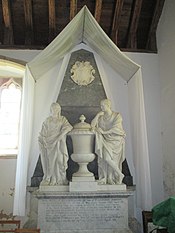
On the south wall is a marble memorial to Sir Merrik Burrell, governor of the Bank of England from 1758 to 1760 who had bought the West Grinstead estate in 1744. It is by the little recorded Nathaniel Smith, a pupil of Joseph Nollekens. The large memorial in the south aisle, with a decorative funerary Roman vase motif is dedicated to Sussex historian Sir William Burrell (1732 - 1796) and his wife, Sophia Raymond. The neoclassical monument is a fine example of the work of John Flaxman. Flaxman who later worked on designs for Josiah Wedgwood also created a sister monument to Burrell at Holy Trinity Church, Cuckfield. Further examples of his work can be found in West Sussex at St. Mary's church in Petworth and St. Margaret's in Eartham.
In the south aisle is the large and impressive marble monument to William and Elizabeth Powlett by the Flemish sculptor J.M.Rysbrack (1694 - 1770) featuring two life size figures leaning on a romanesque funerary urn. The foremost sculptor of monuments in this period the Powlett monument is a fine example of Rybrack's legacy that also includes sixteen monuments in Westminster Abbey. Also in the south asile is a hatchment painted for Elizabeth Powlett's funeral.


Windows
The north wall has a set of 15th-century Lancet windows although the stained glass depicting St.George flanked by St.Anne, St.Mary and St. Catherine of Alexandria is late 19th-century from the workshop of C.E.Kempe and by Alfred E.Tombleson whose distinctive escutcheon shaped monogram is within. The window is dated 1892 and is dedicated to Annie Katharine Loder, sister-in-law of the Victorian plantsman, Sir Edmund Giles Loder of Leonardslee in nearby Lower Beeding.
In 1913 John Peter 'Pitt' Hornung, an entrepreneur whose wealth came from sugar cane plantations in Portuguese East Africa bought the West Grinstead Park estate from the Burrell family. The window on the south wall is dedicated to Hornung and his Portuguese wife Laura de Paiva Rapozo. It depicts St.George, St.Stephen of Hungary and St.Elizabeth of Portugal with attendant angels and background scenes of a meet of the Crawley and Horsham Hunt at West Grinstead Park. It is by Carl Johannes Edwards (originally Kiviaho) (1914 – 1985) of the Stained Glass Studios in Blackfriars, London and was completed in 1967.
The memorial window in the nave aisle by Florence and Walter Camm of Smethwick is beholden to the Arts and Craft movement and depicts the risen Christ with a kneeling figure of a soldier in Khaki flanked by eighteen angels and the four horsemen of the Apocalypse. The window is dedicated to three fallen soldiers of the Great War: Lt. Colonel. Arthur Houssemayne du Boulay D.S.O, his brother-in-law Lt. John Peter Hornung M.C., the son of Pitt and Laura Hornung and Capt. Francis Spencer Collin. The west window at the end of the south aisle has fragments of 14th-century glass, grisaille with impressive reds and yellows.
The East window above the high altar is of 13th-century stonework and contains late-Victorian painted glass work, also by C.E.Kempe & Co. It shows a crucified Christ, flanked by the Virgin Mary and St.John The Evangelist on the island of Patmos writing the Book of Revelations. The window is dedicated to Sir Walter Wyndham Burrell (1814–1886) The stained-glass window in the Lady chapel is by Clayton and Bell in the gothic revival style.
Church bells
The earliest mention of St.George's church bells is 1518 although the belfry contains six bells that date from 1795, originally cast at the Whitechapel Bell Foundry by Thomas Mears (1775–1832). In 1910 the bells were recast and rehung by Gillett & Johnston of Croydon.
| Bell | Weight | Note | Cast year | Foundry | ||
|---|---|---|---|---|---|---|
| long measure | lb | kg | ||||
| 1 | 3 long cwt 0 qr 13 lb | 349 | 158 | F | 1795 | Thomas Mears of Whitechapel |
| 2 | 3 long cwt 3 qr 16 lb | 436 | 198 | D# | 1795 | Thomas Mears of Whitechapel |
| 3 | 3 long cwt 3 qr 9 lb | 429 | 195 | C# | 1795 | Thomas Mears of Whitechapel |
| 4 | 5 long cwt 0 qr 0 lb | 560 | 254 | C | 1795 | Thomas Mears of Whitechapel |
| 5 | 6 long cwt 1 qr 4 lb | 704 | 319 | A# | 1795 | Thomas Mears of Whitechapel |
| 6 | 8 long cwt 0 qr 7 lb | 903 | 410 | G# | 1795 | Thomas Mears of Whitechapel |
Details of bells by Richard Verrall (Master of Sussex County Association of Change Ringers)
Organs
The Great Organ is by the Hull firm of organ makers Foster & Andrews and was built in 1846 making it the oldest surviving organ by the firm. The organ was originally installed for All Saints' Church, Hessle in Yorkshire and was transported by train to West Grinstead in 1890 as part of the renovations then taking place at St.George's. It contains 150 pipes arranged in three ranks and by 1984 it required a major over-haul, carried out by Bishop & Son of London & Ipswich who were able to source parts from contemporaneous redundant organs. The British Institute of Organ Studies has listed it as an organ of exceptional interest.
St. George's also possesses a portable chamber organ built in London in 1795 by George Pike England (1765-1816). The casing is of mahogany and is ornamated with gothic revival stylings. There are four stops: Stopped Diapason (stopped flute), Dulciana (sweet tone stop), Principal and Fifteenth (superoctave), all enclosed in a nag's head swell box.
Other features
The Baptismal font is 12th-century marble, tapered and arcaded, fitted onto a square 14th-century stem with the corners bevelled off . There are several wall memorials in the chancel to members of the Woodward family who held the Rectory living from 1695 to 1849, including one by John Flaxman on the north wall of the chancel in memory of the wife of Rector John Woodward (1759-1807). The chancel also contains an undated relief to the Duke of Clarence, later William IV by Isaac Gosset. The church has a number of other artifacts that are used during religious services. The communion plate includes a silver cup, standing paten and flagon by the leading Hanoverian goldsmiths Hugh Arnett and Edward Pocock and are dated between 1722 and 1730. The churchyard which was extended in the late 20th century contains a memorial stone to Isabella and Ellen Cowie designed by Eric Gill.
See also
Bibliography
- André, J.Lewis F.S.A. (1892). "West Grinstead Church And The Recent Discoveries In That Edifice". Sussex Archaeological Collections. 38. Sussex Archæological Society: 48–59. doi:10.5284/1085731 – via Archaeology Data Service.
- Baggs, A P; Currie, C R J; Elrington, C R; Keeling, S M; Rowland, A M (1986). Hudson T.P. (ed.). West Grinstead, in a History of The County of Sussex (Volume 6 Part 2 Bramber Rape ed.). London: Institute of Historical Research. pp. 83–89.
- Elphick, George P (1970). Sussex Bells and Belfries. Phillimore & Co Ltd. pp. 407–8. ISBN 0900592087.
- Godfrey, Walter Hinds, F.R.I.B.A. (1953). Parish Church of St.George, West Grinstead (May ed.). Sussex Record Society. pp. 277–280.
{{cite book}}: CS1 maint: multiple names: authors list (link) - Nairn, Ian; Pevsner, Nikolaus (1965). The Buildings of England: Sussex. Harmondsworth: Penguin Books. ISBN 0-14-071028-0.
- Painton, Cowen (1985). A Guide to Stained Glass in Britain. Michael Joseph. ISBN 0718125673.
- Turner, Edward (1870). "Steyning and West Grinstead Churches, and the Ancient Castle of Knepp". Sussex Archaeological Collections. 22. Sussex Archaeological Society: 1–21. doi:10.5284/1085409 – via Archaeology Data Service.
- Vigar, John (1986). Exploring Sussex Churches. Rainham: Meresborough Books. ISBN 0-948193-09-3.
- Weller, Leslie F.R.I.C.S. (1990). The Parish Church of St. George, West Grinstead: Its History & Antiquities. Sussex. pp. 1–16.
{{cite book}}: CS1 maint: location missing publisher (link) - Whiteman, Ken; Whiteman, Joyce (1998). Ancient Churches of Sussex (2nd ed.). Seaford: S.B. Publications. ISBN 1-85770-154-2.
- Williamson, Elizabeth; Hudson, Tim; Musson, Jeremy; Nairn, Ian (2019). The Buildings Of England: Sussex: West. London & Newhaven: Yale University Press. pp. 696–700. ISBN 9780300225211.
Gallery
-
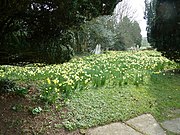 The churchyard of St. George's, West Grinstead
The churchyard of St. George's, West Grinstead
-
 Sir William Burrell monument by John Flaxman
Sir William Burrell monument by John Flaxman
-
 Sir Merrik Burrell memorial sculpted by Nathaniel Smith
Sir Merrik Burrell memorial sculpted by Nathaniel Smith
-
 Reredos from c.1912 by C.E. Kempe & Co
Reredos from c.1912 by C.E. Kempe & Co
-
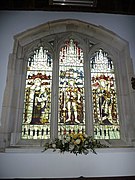 Hornung Memorial Window
Hornung Memorial Window
-
 Rood screen at St.George's, West Grinstead
Rood screen at St.George's, West Grinstead
-
 Church organ by Foster & Andrews from 1846
Church organ by Foster & Andrews from 1846
-
 Footpath south to the causeway and Adur river
Footpath south to the causeway and Adur river
-
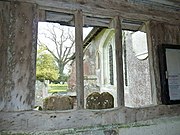 Inside late Medieval porch at St.George's
Inside late Medieval porch at St.George's
-
 Stained-glass window painted by Walter Camm c.1925
Stained-glass window painted by Walter Camm c.1925
-
 The Vestry at St.George's
The Vestry at St.George's
-
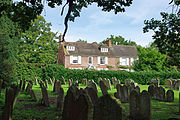 Glebe House, formerly The Rectory
Glebe House, formerly The Rectory
References
- Historic England. "St George's Church (1284797)". National Heritage List for England. Retrieved 31 March 2023.
- ^ Weller, Leslie F.R.I.C.S. (1990). The Parish Church of St. George, West Grinstead: Its History & Antiquities. Sussex. pp. 1–16.
{{cite book}}: CS1 maint: location missing publisher (link) - Historic England. "Glebe House (1026846)". National Heritage List for England. Retrieved 31 March 2023.
- ^ Baggs, A P; Currie, C R J; Elrington, C R; Keeling, S M; Rowland, A M (1986). Hudson T.P. (ed.). West Grinstead, in a History of The County of Sussex (Volume 6 Part 2 Bramber Rape ed.). London: Institute of Historical Research. pp. 83–89.
- Birch, Roger (2006). Sussex Stone, The Story of Horsham Stone and Sussex Marble. West Sussex: self published. p. 64. ISBN 9780955125904.
- Rotuli Litterarum Patentium (Register of Patents issued)1201-16. Church Commission. 1835. p. 155.
- ^ Hussey, Arthur (1852). Notes on the churches in the counties of Kent, Sussex, and Surrey, mentioned in Domesday book, and those of more recent date. 52,Soho Square, London: John Russell Smith. p. 177. Retrieved 31 March 2023.
{{cite book}}: CS1 maint: location (link) - André, J.Lewis F.S.A. (1892). West Grinstead Church And The Recent Discoveries In That Edifice (Vol.38 ed.). Sussex Archæological Society. pp. 48–59.
- ^ Warren, John F.S.A. F.R.I.B.A. (1990). The Architectural Enigma:The Parish Church of St.George, West Grinstead. Sussex. pp. 1–6.
{{cite book}}: CS1 maint: location missing publisher (link) - "St.George's, West Grinstead". Sussex Parish Churches.
- ^ Turner, Edward (1870). Steyning and West Grinstead Churches, and the Ancient Castle of Knepp. Sussex Archaeological Society. pp. 1–21.
- Godfrey, Walter Hinds, F.R.I.B.A. (1953). Parish Church of St.George, West Grinstead (May ed.). Sussex Record Society. pp. 277–280.
{{cite book}}: CS1 maint: multiple names: authors list (link) - "Wall Paintings: Anticipating and Responding to their Discovery". Historic England. Retrieved 3 April 2023.
- Bergdoll, Barry (2000). European Architecture 1750-1890. Oxford University Press. ISBN 978-0-19-284222-0.
- Baggs, A P; Currie, C R J; Elrington, C R; Keeling, S M; Rowland, A M (1986). Hudson T.P. (ed.). West Grinstead, in a History of The County of Sussex: Roman Catholicism (Volume 6 Part 2 Bramber Rape ed.). London: Institute of Historical Research. pp. 102–104.
- ^ Sussex Record Society (xii ed.). p. 236.
- Chicele, Henry (1937–47). E.F. Jacob (ed.). The Register of Henry Chichele, Archbishop of Canterbury, 1414- 1443 (ii 611 lxxviii ed.). Canterbury and York Society. pp. 75–76.
- ^ Williamson, Elizabeth; Hudson, Tim; Musson, Jeremy; Nairn, Ian (2019). The Buildings Of England: Sussex: West. London & Newhaven: Yale University Press. pp. 696–698. ISBN 9780300225211.
- Chisholm, Hugh, ed. (1911). "Piscina" . Encyclopædia Britannica. Vol. 21 (11th ed.). Cambridge University Press. p. 651.
- The English College, Douai, 1750–1794 (1969). British Catholic History. Vol. 10 (Volume 10, Issue 2 ed.). Cambridge University Press. pp. 79–95. doi:10.1017/S0034193200000212. S2CID 163973263. Retrieved 3 April 2023.
{{cite book}}: CS1 maint: multiple names: authors list (link) CS1 maint: numeric names: authors list (link) - Richard Roberts; David Kynaston, eds. (1995). The Bank of England: Money, Power and Influence 1694-1994. Oxford: Oxford University Press. p. 248. ISBN 0-19-828952-9.
- "Nathaniel Smith". The British Museum. Retrieved 3 April 2023.
- Chisholm, Hugh, ed. (1911). "Nollekens, Joseph" . Encyclopædia Britannica. Vol. 19 (11th ed.). Cambridge University Press. p. 734.
- Irwin, David (1979). John Flaxman,1755-1826: Sculptor, Illustrator, Designer. Littlehampton Book Services Ltd. p. 280. ISBN 9780289708859.
- Rysbrack, John Michael: Biography. Accessed 4 April 2023.
- Robert Williams and Katharine Eustace, Rysbrack family [Rysbraeck] at Grove Art Online Accessed 4 April 2023
- "Architects & Artists TUV: A E Tombleson". Sussex Parish Churches. Retrieved 4 April 2023.
- Pease, Arthur E. (2015). Edmund Loder, Naturalist, Horticulturist, Traveller and Sportsman: A Memoir (1923). Palala Press. p. 374. ISBN 9781341168437.
- Vail, Leroy; White, Landeg (1980). Capitalism and Colonialism in Mozambique. Heineman. ISBN 9780816610396.
- "Artists, Craftesmen And Conservators:Carl Edwards". Benyon Stained Glass. Retrieved 4 April 2023.
- British Commonwealth War Graves Registers, 1914-1918. London, England: Commonwealth War Graves Commission
- Painton, Cowen (1985). A Guide to Stained Glass in Britain. Michael Joseph. ISBN 0718125673.
- ^ Verrall, Richard (1990). The Parish Church of St. George, West Grinstead: Its History & Antiquities. Sussex: The Bells. pp. 10–11.
- Elphick, George P (1970). Sussex Bells and Belfries. Phillimore & Co Ltd. pp. 407–8. ISBN 0900592087.
- ^ Elvin, Laurence (1968). Forster And Andrews Organ Builders 1843-1956. Elvin. p. 80. ISBN 9780950004907.
- Historic England. "Church of All Saints (1161766)". National Heritage List for England. Retrieved 4 April 2023.
- "Bishop & Son,Organ Builders - Ipswich Est: 1795". Retrieved 2 April 2023.
- ^ Campbell, Dr Andrew (1990). The Parish Church of St.George, West Grinstead: Its History & Antiquities: The Organs. Parish publication. pp. 8–9.
- "Historic Organ Listing". The British Institute of Organ Studies (BIOS). Retrieved 2 April 2023.
- Chaffers, William (1883). A History of English Goldsmiths and Plateworkers (PDF). London: W.H.Allen & Co.
External links
- Official website (Parish of West Grinstead)
![]() Media related to St George's Church, West Grinstead at Wikimedia Commons
Media related to St George's Church, West Grinstead at Wikimedia Commons